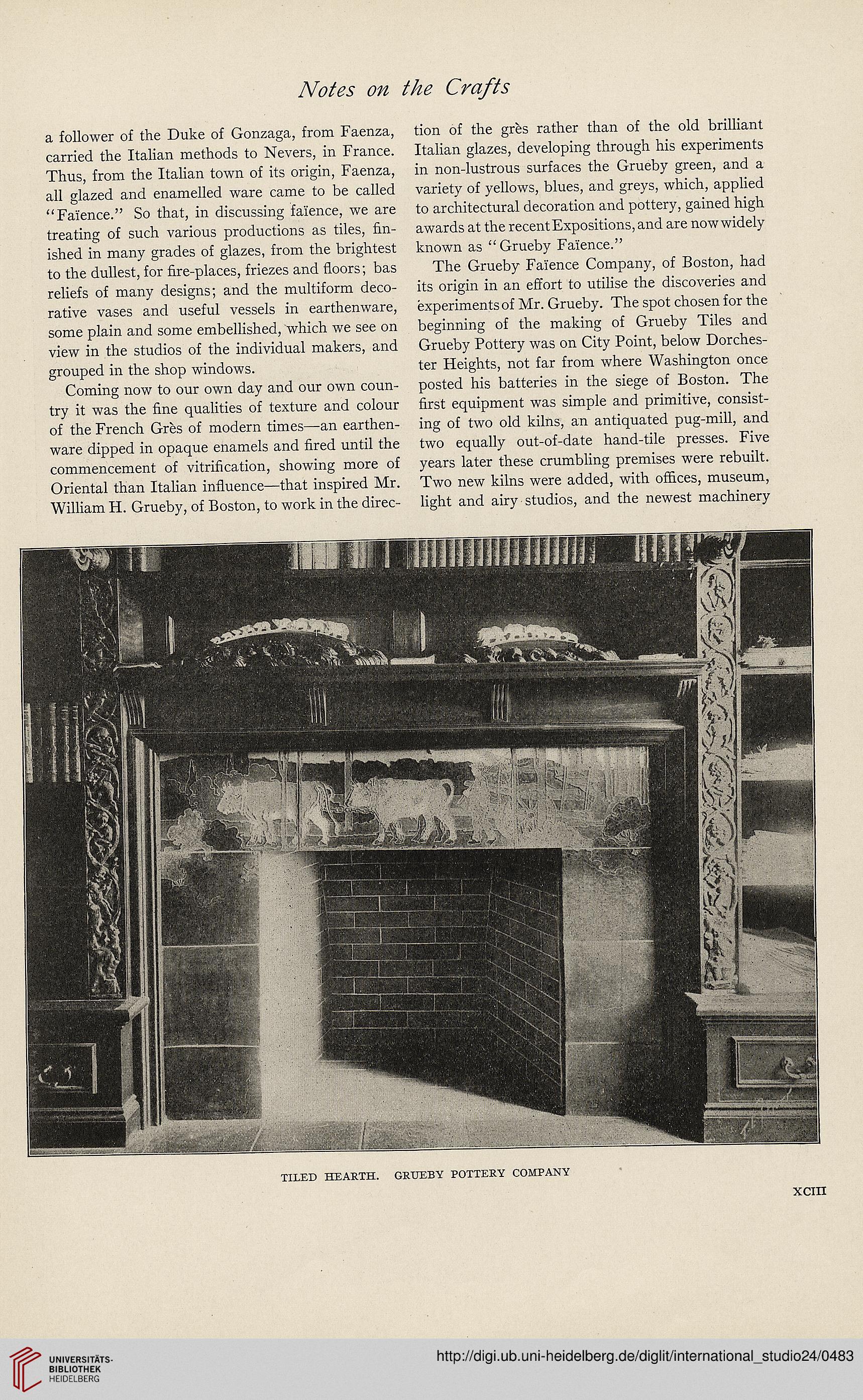Notes on the Crafts
a follower of the Duke of Gonzaga, from Faenza,
carried the Italian methods to Nevers, in France.
Thus, from the Italian town of its origin, Faenza,
all glazed and enamelled ware came to be called
“Faience.” So that, in discussing faience, we are
treating of such various productions as tiles, fin-
ished in many grades of glazes, from the brightest
to the dullest, for fire-places, friezes and floors; bas
reliefs of many designs; and the multiform deco-
rative vases and useful vessels in earthenware,
some plain and some embellished, which we see on
view in the studios of the individual makers, and
grouped in the shop windows.
Coming now to our own day and our own coun-
try it was the fine qualities of texture and colour
of the French Gres of modern times—an earthen-
ware dipped in opaque enamels and fired until the
commencement of vitrification, showing more of
Oriental than Italian influence—that inspired Mr.
William H. Grueby, of Boston, to work in the direc-
tion of the gres rather than of the old brilliant
Italian glazes, developing through his experiments
in non-lustrous surfaces the Grueby green, and a
variety of yellows, blues, and greys, which, applied
to architectural decoration and pottery, gained high
awards at the recent Expositions, and are now widely
known as “Grueby Faience.”
The Grueby Faience Company, of Boston, had
its origin in an effort to utilise the discoveries and
experiments of Mr. Grueby. The spot chosen for the
beginning of the making of Grueby Tiles and
Grueby Pottery was on City Point, below Dorches-
ter Heights, not far from where Washington once
posted his batteries in the siege of Boston. The
first equipment was simple and primitive, consist-
ing of two old kilns, an antiquated pug-mill, and
two equally out-of-date hand-tile presses. Five
years later these crumbling premises were rebuilt.
Two new kilns were added, with offices, museum,
light and airy studios, and the newest machinery
TILED HEARTH. GRUEBY POTTERY COMPANY
XCIII
a follower of the Duke of Gonzaga, from Faenza,
carried the Italian methods to Nevers, in France.
Thus, from the Italian town of its origin, Faenza,
all glazed and enamelled ware came to be called
“Faience.” So that, in discussing faience, we are
treating of such various productions as tiles, fin-
ished in many grades of glazes, from the brightest
to the dullest, for fire-places, friezes and floors; bas
reliefs of many designs; and the multiform deco-
rative vases and useful vessels in earthenware,
some plain and some embellished, which we see on
view in the studios of the individual makers, and
grouped in the shop windows.
Coming now to our own day and our own coun-
try it was the fine qualities of texture and colour
of the French Gres of modern times—an earthen-
ware dipped in opaque enamels and fired until the
commencement of vitrification, showing more of
Oriental than Italian influence—that inspired Mr.
William H. Grueby, of Boston, to work in the direc-
tion of the gres rather than of the old brilliant
Italian glazes, developing through his experiments
in non-lustrous surfaces the Grueby green, and a
variety of yellows, blues, and greys, which, applied
to architectural decoration and pottery, gained high
awards at the recent Expositions, and are now widely
known as “Grueby Faience.”
The Grueby Faience Company, of Boston, had
its origin in an effort to utilise the discoveries and
experiments of Mr. Grueby. The spot chosen for the
beginning of the making of Grueby Tiles and
Grueby Pottery was on City Point, below Dorches-
ter Heights, not far from where Washington once
posted his batteries in the siege of Boston. The
first equipment was simple and primitive, consist-
ing of two old kilns, an antiquated pug-mill, and
two equally out-of-date hand-tile presses. Five
years later these crumbling premises were rebuilt.
Two new kilns were added, with offices, museum,
light and airy studios, and the newest machinery
TILED HEARTH. GRUEBY POTTERY COMPANY
XCIII




